Path of Taste: Montefalco e Colli Martani
This central area of Umbria is distinguished by the presence of numerous villages, tourist attractions and valuable natural areas. It is characterized by the production of very high quality wines and olive oils. The main towns to visit are Montefalco (a quintessential village and the proud homeland of Sagrantino di Montefalco and Rosso), Spello, Bevagna, Cannara, Trevi (produce olive oil and DOC “Colli Martani” wines), Todi, and Foligno (home to the popular event Festival de I Primi d’Italia).
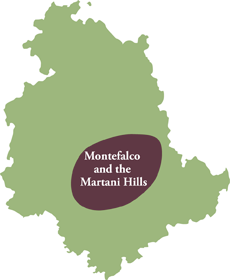
How to get here:
Car: Superstrada E45
Car: Strada statale 209 “tre Valli Umbre”
Train: Stazione ferroviaria Foligno
PLACES TO VISIT
Montefalco and the land of Sagrantino
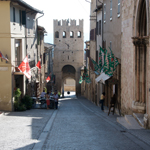 A small zone in the centrer of Umbria characterized by the strada (road) del Sagrantino and the municipalities belonging to it. Montefalco is the center, and also in the list of the most beautiful towns in Italy. Pirched above panoramic valleys and vineyards, that earned it the nickname the Balcony of Umbria. Entering the town from Porta Augustino has a beautiful view of Corso Mameli near a public park where there is also the church of St. Augustino and the beautiful Terziere tower. The Piazza del Comune (town square) hosts the beautiful town hall. From Porta della Rocca, (the other entrance to the village) there is the beautiful fourteenth-century church of San Francesco also home to the local art gallery.
A small zone in the centrer of Umbria characterized by the strada (road) del Sagrantino and the municipalities belonging to it. Montefalco is the center, and also in the list of the most beautiful towns in Italy. Pirched above panoramic valleys and vineyards, that earned it the nickname the Balcony of Umbria. Entering the town from Porta Augustino has a beautiful view of Corso Mameli near a public park where there is also the church of St. Augustino and the beautiful Terziere tower. The Piazza del Comune (town square) hosts the beautiful town hall. From Porta della Rocca, (the other entrance to the village) there is the beautiful fourteenth-century church of San Francesco also home to the local art gallery.
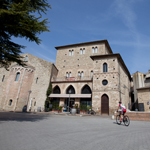 Bevagna is another village in the list of the most beautiful villages in Italy is the nearby. A typical Umbrian town, in the center is the beautiful Piazza Silvestri, a pleasant mix of old buildings in white stone and the Palazzo dei Consoli from the thirteenth century. Other worthy stops are the churches San Domenico and San Silvestro and the original ancient public wash-house. Bevagna hosts the annual event the “Mercato delle Gaite”: this historical event is a show that recreates everyday life between 1250 and 1350, in commemoration of the four Gaite (neighborhoods) St. George, St. John, St. Peter and St. Mary, who compete in four competitions (crafts, culinary, market and archery).
Bevagna is another village in the list of the most beautiful villages in Italy is the nearby. A typical Umbrian town, in the center is the beautiful Piazza Silvestri, a pleasant mix of old buildings in white stone and the Palazzo dei Consoli from the thirteenth century. Other worthy stops are the churches San Domenico and San Silvestro and the original ancient public wash-house. Bevagna hosts the annual event the “Mercato delle Gaite”: this historical event is a show that recreates everyday life between 1250 and 1350, in commemoration of the four Gaite (neighborhoods) St. George, St. John, St. Peter and St. Mary, who compete in four competitions (crafts, culinary, market and archery).
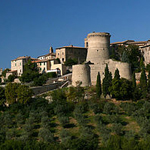 Gualdo Cattaneo is a short distance from Bevagna, whose most important monument is the ancient Rocca, a triangular fortress with a central tower and two side rondelle communicating with each other through a system of underground tunnels. Built between 1494 and 1498 at the behest of the city of Foligno, designed by Francesco di Bartolomeo di Pietrasanta. The nearby town of Grutti, is home to the Slow Food traditional Cicotto Umbro.
Gualdo Cattaneo is a short distance from Bevagna, whose most important monument is the ancient Rocca, a triangular fortress with a central tower and two side rondelle communicating with each other through a system of underground tunnels. Built between 1494 and 1498 at the behest of the city of Foligno, designed by Francesco di Bartolomeo di Pietrasanta. The nearby town of Grutti, is home to the Slow Food traditional Cicotto Umbro.
Foligno and the highlands of Colfiorito
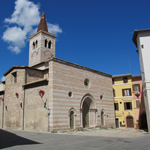 Foligno a dynamic city rich in monuments. Its historic center is characterized by the beautiful Piazza della Repubblica and the Duomo, has many interesting views and historic buildings such as churches and Palazzi Trinci, the Palazzo del Podesta, in addition to the churches of Santa Maria Infraportas, Sant’ Agostino, and St. Nicholas. Natural attractions in the area and the natural park of Colfiorito and the Fonti del Clitunno. This small park has a pond inside with crystal clear waters that is the source of the Clitunno river, on whose banks grow green shady poplar trees are ideal for a romantic walk in the sun. It is said that this site was known since ancient times and was full of villas, temples and spa areas in the Roman era, all of this we can now appreciate the splendor of ancient small temple in the park, which is dedicated to the god Clitunno. In the area there is also the village of Campello sul Clitunno. This village is divided between the base and the old “ Campello Alto” an old town surrounded by ancient walls of the fort and the remains of the ancient castle dating to the year 925. Foligno has become an increasingly popular destination for food and wine lover because of the year event Festival dei Primi Piatti (festival of first courses).
Foligno a dynamic city rich in monuments. Its historic center is characterized by the beautiful Piazza della Repubblica and the Duomo, has many interesting views and historic buildings such as churches and Palazzi Trinci, the Palazzo del Podesta, in addition to the churches of Santa Maria Infraportas, Sant’ Agostino, and St. Nicholas. Natural attractions in the area and the natural park of Colfiorito and the Fonti del Clitunno. This small park has a pond inside with crystal clear waters that is the source of the Clitunno river, on whose banks grow green shady poplar trees are ideal for a romantic walk in the sun. It is said that this site was known since ancient times and was full of villas, temples and spa areas in the Roman era, all of this we can now appreciate the splendor of ancient small temple in the park, which is dedicated to the god Clitunno. In the area there is also the village of Campello sul Clitunno. This village is divided between the base and the old “ Campello Alto” an old town surrounded by ancient walls of the fort and the remains of the ancient castle dating to the year 925. Foligno has become an increasingly popular destination for food and wine lover because of the year event Festival dei Primi Piatti (festival of first courses).
Almost equidistant from Foligno and positioned respectively north and south of the city, are the charming villages of Spello and Trevi, both of which are also on the list of the most beautiful villages of Italy.
 Spello is a picturesque Umbrian village rich in Roman history seen in Augustan walls and doors (the beautiful Porta Venere, Consular Door, Door Urbica), the ruins of the amphitheater and thermal baths. Spello is also another story, with beautiful and typical internal streets and churches, including the Church of Santa Maria Maggiore and San Claudio. Near the latter is also the beautiful Villa Costanzi or Fidelia with its wide open spaces and gardens, for some years an appointed place for events. To note the close link between Spello and olive oil is the event L’Oro di Spello (the gold of Spello) a food and wine festival.
Spello is a picturesque Umbrian village rich in Roman history seen in Augustan walls and doors (the beautiful Porta Venere, Consular Door, Door Urbica), the ruins of the amphitheater and thermal baths. Spello is also another story, with beautiful and typical internal streets and churches, including the Church of Santa Maria Maggiore and San Claudio. Near the latter is also the beautiful Villa Costanzi or Fidelia with its wide open spaces and gardens, for some years an appointed place for events. To note the close link between Spello and olive oil is the event L’Oro di Spello (the gold of Spello) a food and wine festival.
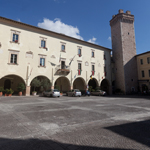 Trevi is situated in a hilly panoramic area surrounded by vineyards and olive groves. Downtown you can visit the churches of Sant Emiliano and San Francesco. While just outside of town is the beautiful Villa Fabbri with its large garden and ancient olive trees. Outside of Trevi the village Bovara, in the middle of a small plot of land with olive trees, it is nestled between the famous fences “Olivo Sant’Emiliano“, this olive tree is considered one of the oldest in the world is truly monumental and almost “clumsy” with huge gnarled branches.
Trevi is situated in a hilly panoramic area surrounded by vineyards and olive groves. Downtown you can visit the churches of Sant Emiliano and San Francesco. While just outside of town is the beautiful Villa Fabbri with its large garden and ancient olive trees. Outside of Trevi the village Bovara, in the middle of a small plot of land with olive trees, it is nestled between the famous fences “Olivo Sant’Emiliano“, this olive tree is considered one of the oldest in the world is truly monumental and almost “clumsy” with huge gnarled branches.
Further to the east you will reach the side of the Apennines characterized by the presence of the highlands and marshes of Colfiorito, particularly attractive to nature lovers.
Todi and Massa Martana
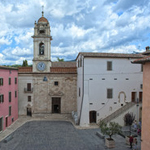 Behind the Martani hills lies Massa Martana, a village of Roman origin has a beautiful old town with palaces and buildings made of the typical white-stone. Just outside are the beautiful Abbies of San Terenzio and Fidenzio, and the churches of Santa Maria and Santa Illuminata. Other attractions of Massa Martana the convent of St. Peter and the Christian catacombs can be visited by appointment. Massa Martana boasts a particularly fertile territory for the production of wine and olive oil.
Behind the Martani hills lies Massa Martana, a village of Roman origin has a beautiful old town with palaces and buildings made of the typical white-stone. Just outside are the beautiful Abbies of San Terenzio and Fidenzio, and the churches of Santa Maria and Santa Illuminata. Other attractions of Massa Martana the convent of St. Peter and the Christian catacombs can be visited by appointment. Massa Martana boasts a particularly fertile territory for the production of wine and olive oil.
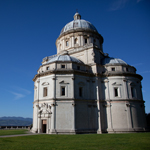 Todi is located just a half hour from Massa Martana. The birthplace of Jacopone and characterized by the typical white stone and travertine buildings with Piazza del Popolo in thecenter. In this square are the Cathedral and some elegant historic buildings including the Palazzo del Popolo and Palazo dei Priori. Other attractions in the city are found in the beautiful church of San Fortunato and the square just outside the city center where stands the majestic Santuario della Consolazione. The small village of Montecastello Vibio is near Todi and hosts the “Teatro Piccolo”, the smallest theater in the world.
Todi is located just a half hour from Massa Martana. The birthplace of Jacopone and characterized by the typical white stone and travertine buildings with Piazza del Popolo in thecenter. In this square are the Cathedral and some elegant historic buildings including the Palazzo del Popolo and Palazo dei Priori. Other attractions in the city are found in the beautiful church of San Fortunato and the square just outside the city center where stands the majestic Santuario della Consolazione. The small village of Montecastello Vibio is near Todi and hosts the “Teatro Piccolo”, the smallest theater in the world.
LOCAL WINES
DOCG “Sagrantino di Montefalco”
This great wine of central Umbria is produced in the territory of Montefalco, Bevagna, Gualdo Cattaneo, Castel Ritaldi, and Giano dell’Umbria. This wine is made from 100% Sagrantino grapes and it has been a DOCG wine since 1992 denomination of controlled and guaranteed origin granted in 1992 is reserved for red wine in the types “Secco” and “Passito”. Sagrantino di Montefalco is a wine with intense ruby color pairing well with game and red meats.
DOC “Montefalco”
Another Umbrian wine of great value and appreciation which is produced in the territory of Montefalco and the surrounding municipalities: Red made from Trebbiano and Grechetto (also Reserve) and White made from primarily Sangiovese and a small part of Sagrantino. The Red wine is best with meat and game, and the white can be considered a wine for any meal.
DOC “Colli Martani”
A wine produced in the center of Umbria and that got it’s designation in 1988. Product in a wide area of central Umbria geographically characterized precisely by the chain of Martani Hills. It is produced in different types including the very popular white Grechetto great for meals with fish, and red Sangiovese Colle Martani (also Reserve) great for red meats and game.
DOC “Todi”
A wine which recently acquired the designation of origin (2010) in the territory comprised in the production of the Colli Martani DOC. In particular, this wine is produced in the types: Grechetto, White, Red, Merlot and Sangiovese.
IGT “Cannara”
Red wines in standard typologies and produced in the territories of Bettona, Bevagna and Cannara.
IGT “Spello”
White, Red and Rosè wines.
WINERIES
Wineries Montefalco and the Martani Hills
The best wineries and wine producers in the area of Montefalco and the hills of Martani: a large territory in the heart of Umbria, where they produce the excellent Sagrantino di Montefalco DOCG and DOC wines of Umbria like “Todi” and “Colle Martani”. Many local wineries offer direct sales services and wine tastings, as well as vineyard tours and the various phases of wine production.
LOCAL PRODUCTS
Extra Virgin Olive Oil DOP – Colli Martani
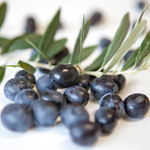 A quality oil of the Martani Hills area which is obtained from the most common olive varieties of the region (Moraiolo, Leccino, Frantoio).
A quality oil of the Martani Hills area which is obtained from the most common olive varieties of the region (Moraiolo, Leccino, Frantoio).
Cipolla (Onion) di Cannara
 Grown in a restricted area of Umbria with potassium rich clay soil and water. It is a product of great quality and taste, and a base of many dishes from Umbria.
Grown in a restricted area of Umbria with potassium rich clay soil and water. It is a product of great quality and taste, and a base of many dishes from Umbria.
Sedano nero (balck Celery) di Trevi
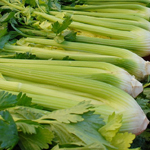 Produced in small quantities and now grown only in certain areas around Clitunno and Trevi, this celery has a dense and tender meat with typical ribs, and is especially popular in local dishes such as parmigiana di sedano nero.
Produced in small quantities and now grown only in certain areas around Clitunno and Trevi, this celery has a dense and tender meat with typical ribs, and is especially popular in local dishes such as parmigiana di sedano nero.
Fagiolo (Bean) di Cave (Foligno)
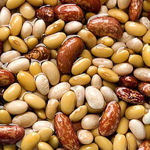 Produced in two varieties (light green and yellow) in the small hamlet quarries on the Topino river in Foligno, has a light savory taste and is characterized by a very thin skin.
Produced in two varieties (light green and yellow) in the small hamlet quarries on the Topino river in Foligno, has a light savory taste and is characterized by a very thin skin.
Patata rossa di Colfiorito IGP
 A traditional vegetable from the area of Colfiorito, recognized by its thin rough dull red skin, and crisp pale yellow meat. In the kitchen it is suitable for every type of preparation: boiled, grilled, or under ashes, salads, fried, roasted, or used to produce breads, even mashed to be used as a base for excellent desserts such as ciambelle di patata rossa.
A traditional vegetable from the area of Colfiorito, recognized by its thin rough dull red skin, and crisp pale yellow meat. In the kitchen it is suitable for every type of preparation: boiled, grilled, or under ashes, salads, fried, roasted, or used to produce breads, even mashed to be used as a base for excellent desserts such as ciambelle di patata rossa.
Formaggio Ravaggiolo
 A fresh cheese whose origin date back to the 1500’s. It is produced primarily with cow’s milk, but you can sometimes find the same product with sheep or goat’s milk. This cheese is soft and tender with a remarkable creaminess. Due to its characteristics it must be consumed within a few days.
A fresh cheese whose origin date back to the 1500’s. It is produced primarily with cow’s milk, but you can sometimes find the same product with sheep or goat’s milk. This cheese is soft and tender with a remarkable creaminess. Due to its characteristics it must be consumed within a few days.
Cicotto Umbro
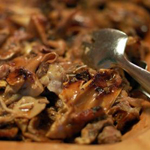 A dish once widespread throughout the region, which can still be sampled in particular locations. It is traditionally made by using all cuts of pork: feet, knuckles, ears, tongue, tripe and other innards. After they are hand boned and carefully processed, the parts are mixed with the other pieces of pork. The mixture is placed inside a container and into a firing kiln. Cicotto is slow cooked for 9-12 hours at a temperature of about 200°C. An aromatic and tasty dish, soft and full of flavor. Cicotto Umbro is part of Slow Food in the village of Grutti, between Gualdo Cattaneo and Todi.
A dish once widespread throughout the region, which can still be sampled in particular locations. It is traditionally made by using all cuts of pork: feet, knuckles, ears, tongue, tripe and other innards. After they are hand boned and carefully processed, the parts are mixed with the other pieces of pork. The mixture is placed inside a container and into a firing kiln. Cicotto is slow cooked for 9-12 hours at a temperature of about 200°C. An aromatic and tasty dish, soft and full of flavor. Cicotto Umbro is part of Slow Food in the village of Grutti, between Gualdo Cattaneo and Todi.
PRODUCERS AND FOOD SHOPS
Local Producers of Montefalco and the Martani Hills
Agricultural companies, typical products and farms in the central area of Umbria, with typical Umbrian villages, many of which are reported among the most beautiful in Italy; Montefalco, Spello, Trevi, Bevagna. Local production of produce like onions, celery, vegetables, and products like extra virgin olive oil, cheeses and craft beers.
TYPICAL DISHES
First Courses
- Strangozzi o Umbrichelli al tartufo: a type of long hand-made pasta of water and flour, in this version is very common in the area topped with black truffle sauce.
- Pappardelle al cinghiale: long hand-made thickly cut egg pasta, with a wild boar sauce where the meat is flavored with spices including, onion, rosemary, thyme, and juniper.
- Pane al mosto di Foligno: a typical bread where the dough is made from grape must.
Second Courses
- Salsicce con lenticchie: a classic Umbrian dish made from pork sausages accompanied by white lentils.
- Caciotta e pecorino umbro o formaggio Raviggiolo: soft cheeses made from cow or sheep milk, or just matured cheeses.
- Salumi ed insaccati vari: variety of dried and spiced sausages.
- Coratella d’agnello: tasty dish made from lamb interiors with tomato sauce, onion, pepper.
- Pollo arrosto: a classic Umbrian dish, roasted chicken flavored with wild fennel or rosemary.
- Faraona in salmì: a delicious dish of guinea fowl dressed with an oil, vinegar, and caper sauce.
- Porchetta e zampetti di maiale: a traditional Umbrian country dish of wood oven roasted pork, flavored with fennel and black pepper.
- Lumache di Cantalupo: typical an excellent dish of Cantalupo, but has spread throughout the area, snails prepared with fresh tomato sauce, fennel, onion, garlic and chili.
- Uova al tartufo: a very common dish of the local table, egg omelette made with black truffle.
- Parmigiana di cipolla rossa di Cannara: a twist on the classic eggplant parmigiana. The fried eggplant base is topped with tomato, cheese or fresh mozzarella, and red onion of Cannara with an unmistakable taste.
- Parmigiana al sedano nero di Trevi: parmigiana revisited where the prized black celery of Trevi replaces the class eggplant.
Dolci
- Zuppa inglese
- Mostaccioli
- Nociata umbra (torrone)
RESTAURANTS AND TRATTORIAS
Restaurants Montefalco and the Martani Hills
Restaurants, trattorias and wine bar in central Umbria; Montefalco, Bevagna, Todi and the Martani Hills. An area where you can find restaurants that offer the best of local cuisine. Among the most typical dishes to try: Spaghetti al rancetto, fagioli e cotiche (beans & pork rind), porchetta di maiale (pork), agnello (lamb) al tartufo, parmigiana al sedano nero (black celery).
EXPERIENCES
LOCAL EVENTS & FESTIVALS
Bevagna
- Mercato delle Gaite
- Primavera Medioevale – Esposizione e vendita dei prodotti enogastronomici artigianali
- Sagra della Lumaca – Cantalupo di Bevagna
Cannara
- Festa della Cipolla
Foligno
- Festival dei Primi d’Italia
Massa Martana
- Sagra della POLENTA – (località Viepri)
Montefalco
- Terre del Sagrantino
Spello
- L’Oro di Spello – Festa dell’Olivo e Sagra della Bruschetta
Trevi
- Sagra del Sedano Nero e della Salsiccia

 Wine Production
Wine Production Wine Tastings
Wine Tastings Restaurant
Restaurant Wine Retail
Wine Retail Products Retail
Products Retail Bio Production
Bio Production Beer Production
Beer Production